New: The Alpha A6300 has since been replaced by the Alpha A6500, but it remains in the Sony mirrorless line-up. The A6500 features a number of performance improvements, as well as touchscreen control. Don't discount the A6300 as it's still a very capable mirrorless camera, and is now more affordable than ever.
Sony may have spent the last few years reshaping the full-frame market with a string of popular compact system cameras, but it's also managed to simultaneously keep its APS-C alternatives relevant and exciting.
Its previous A6000 was very much testament to this, with a well-rounded spec sheet and excellent performance helping it to become a successful model for the company. Thankfully, the new A6300 retains what made that model so popular, but the areas in which Sony has sought to improve it should give it many added layers of appeal to enthusiast users, whether they tend to shoot sports, video or something else.
As an upper-level APS-C model the camera goes up against the likes of the Fujifilm X-T2, as well as the newer and pricier X-Pro2, together with Micro Four Thirds offerings such as the Olympus Pen-F and more affordable Panasonic Lumix GX8. Interestingly, at its current price, it also occupies something of a middle ground against Sony's full-frame alternatives, being a little cheaper than the Alpha A7 II but pricier than the still-available A7 and A7R.
Features
The Exmor CMOS APS-C sensor maintains the same 24.2MP pixel count as the one inside the A6000, although the sensor itself is newly developed, and features copper wiring in its construction to boost readout speed and light-gathering efficiency.
Sony has also said that refinements to the camera’s BIONZ X processing engine mean it can squeeze all the goodness out of the new sensor, with particular focus on low-noise, high-resolution results in the upper range of the camera’s ISO100-51,200 sensitivity span.
Sony has also equipped the camera with its 4D Focus system, with 425 phase-detect AF pixels that reach almost to the peripheries of the frame. This is the highest number of phase-detect points we’ve seen on an interchangeable-lens camera to date, and this density, together with 169 additional contrast-detect points, is said to enable the camera to focus on moving subjects in as little as 0.05 seconds.
Furthermore, the camera’s phase-detect points continue to function when using A-mount lenses via an adapter, which will no doubt please those moving up from the older system.
Those intending to use the camera for moving subjects will also be pleased to learn that not only has the 11fps burst-shooting option of the A6000 been maintained – with focus tracking and exposure adjusted throughout the burst – but that a slightly slower 8fps alternative option is also on hand, with a blackout between each frame to provide a similar experience to using an optical viewfinder.
Video recording has also received plenty of attention. In contrast to the Full HD standard on the A6000 and most other cameras at this level, the A6300 ramps up to 4K shooting in the Super 35mm format – a first for a non-full-frame Sony model.
Thanks to the changes made to the focusing system, focus speeds are also said to be twice as fast as the system inside the A6000
Instead of using pixel binning, this captures 6K footage – i.e. oversampling the scene – before downsampling it to a 4K resolution, a process that Sony claims produces 'exceptional' depth and detail.
Other changes include a new XAVC S codec used for the above, and the S-Log Gamma function. Thanks to the changes made to the focusing system, focus speeds are also said to be twice as fast as the system inside the A6000, while a 3.5mm mic port has also been included.
The 3-inch display on the rear, with its 921k-dot resolution and ability to be tilted, has been carbon copied from the A6000, which means it's shaped in the video-friendly 16:9 aspect ratio, although sadly it's not a touch-sensitive screen.
The 0.39-inch electronic viewfinder above this, however – or 'Tru-Finder' in Sony parlance – has now been equipped with a 2.359 million-dot XGA OLED panel, against the 1.44 million dots seen previously.
If this viewfinder sounds familiar, it's probably because many other Sony models higher up have also sported one with similar specs, from the Cyber-shot RX1R II compact to the A7 family of mirrorless models. Magnification is once again set at 1.07x, which is roughly equivalent to 0.70x in 35mm terms, and Sony also claims that setting it to its maximum display rate of 120fps results in very few afterimages.
Other changes include improved dust and moisture resistance, although not quite to the same splash-proof level as the Olympus OM-D E-M5 II and Fujifilm X-Pro2
Other changes include improved dust and moisture resistance, although not quite to the same splash-proof level as the Olympus OM-D E-M5 II and Fujifilm X-Pro2, as well as a gauge for keeping shots level, and a new silent shooting mode that should see the camera more suited to sensitive environments.
Battery life has also been boosted, with 350 frames quoted when using the viewfinder and 400 frames when using the LCD screen, although the number actually achieved will be subject to display settings and image-reviewing habits, among other things.
In terms of connectivity, the camera is furnished with the standard USB and HDMI micro connections, with Wi-Fi and NFC on the inside to keep things cable-free where necessary. As with the majority of such models, it records all images and videos onto SD, SDHC and SDXC media (with support for up to UHS-I), as well as the less-common, Sony-specific Memory Stick PRO Duo format.
The A6300 makes a positive first impression. The large, rubbered grip, combined with the body’s depth and the raised edge on the thumb rest, makes it easier to handle than many similar cameras. The body also appears to strike the right balance between offering plenty of logically positioned controls without attempting to cram these onto every surface, causing you to press buttons inadvertently.
Occasionally, however, I felt the grip wasn’t raised far enough from the front plate for it to always be entirely comfortable, particularly when holding the camera between shots. I found the tips of my fingers were often squashed against the front plate, and ultimately I resorted to holding the camera by the lens rather than the grip when carrying it, with my index finger on the back plate for extra security.
The top and front plates are somewhat minimal in their design, with only one button present across both (a customisable control next to the shutter release button/power switch collar). Because of this the camera is able to offer both a built-in flash and a multi-interface shoe in addition to the electronic viewfinder, together with two large dials – a command dial and another for changing the shooting mode.
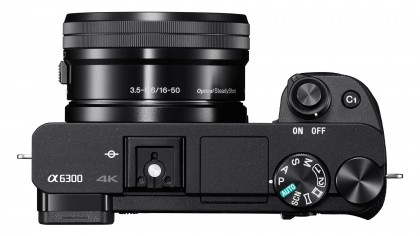
The stiffness of the shooting mode dial is welcome, as most photographers won’t be adjusting this with such frequency that would require it to be looser (and thus more prone to accidental turning). Likewise the stiffness of the command dial next to it, which can be used to adjust aperture, shutter speed, exposure compensation and more – which is perhaps just as well given its more exposed and easy-to-knock edges, although it would be good to see the camera more responsive to its turning, as it can take a fair few turns to get to where you want to be.
The back plate mostly follows a tried-and-tested formula, with a handful of well-marked controls and the loosely moving control wheel enabling you to navigate menus and scrutinize images with ease.
One new change is the arrival of a collar around the magnify button; this can be used in conjunction with the button to select Auto-Exposure Lock, or alternatively to quickly switch to manual focus. This works well and falls right next to the thumb, so it’s great if you often find yourself fine-tuning focus.
The rear display pulls away easily, but is stiff enough to remain in the position to which it’s adjusted. When extended to certain positions, however, some of the most frequently-used controls are awkward to operate, particularly the Fn and menu buttons, as well as the control wheel.
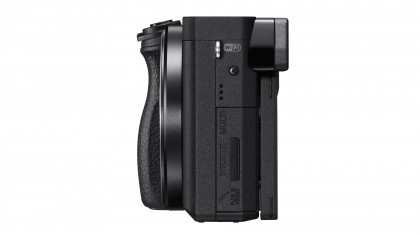
The menu system is comprehensive, with a generally good level of clarity in terms of display and language (a handful of abbreviations are used, although the majority aren’t quite as cryptic as on other cameras).
But, although options are segregated into different tabs, some groups of settings overflow where they could easily be placed under one. Given that there are 27 separate screens, all appearing very similar on account of there being no colour-coding – something present on other Sony models – it can sometimes be difficult to find what you need.
One slight annoyance is the position of the movie record button, right at the edge of the rear plate. During this test, I assigned movie recording to the C1 button on the top plate to make this more convenient to press, although this can be assigned elsewhere should you already have this set to another function of your choosing.
The diopter correction wheel is also in perhaps the least convenient place possible, making adjustments while your face is to the camera unnecessarily awkward.
Although the A6000’s viewfinder was a capable performer it’s still welcome to see this component upgraded on the Sony A6300, given how key a part of the camera it is. As someone who doesn’t wear glasses I found its eye-point to be in just the right spot for me when held at a comfortable distance away. The panel’s resolution provides very good clarity and contrast is high, and although noise and lagging increased in darker conditions I still found it perfectly usable.
The on-screen (shooting) display of the LCD is large and clear, and the fact that images captured in the standard 3:2 aspect ratio do not occupy the entirety of the screen helps, as the black borders on either side allow for most of the secondary shooting information to stand out (the rest is superimposed on the image).
The screen itself appears somewhat underpowered when used outside, however, even under overcast conditions. Switching the camera to the Sunny Weather option, or brightening the display manually, is a great help, although this obviously comes at the expense of battery life.
Although the camera doesn’t quite offer the near-instant start-up time of a similar DSLR, it’s not so far behind that it makes any difference in all but critical situations.
Click here for the full-resolution image

Click here for the full-resolution image

Click here for the full-resolution image

Click here for the full-resolution image
Sony states that the A6300 can shoot 21 consecutive raw frames or the same number of Raw+JPEG frames, and 44 JPEG frames at the highest quality setting. In practice, the camera easily met all of these targets, even exceeding them by the odd frame, although slower memory cards may throttle this.
Helpfully, the camera also remained operational while writing images to the card, not fully functional but often allowing a few subsequent frames to be captured as these were being dealt with.
The revamped focusing system is one of the A6300’s main highlights, so does it deliver on the high expectations? Largely, yes. In good light it brings subjects to focus with very little delay, refocusing whenever the lens is zoomed to an approximate point so that focusing takes as little time as possible when initiated by the user.
The camera also willingly deploys the AF assist light wherever it feels it needs to, which helps to keep focusing speed swift in poorer light.

Click here for the full-resolution image

Click here for the full-resolution image
The high number of phase-detect AF points, and in turn their density, also plays a significant part in ensuring that moving subjects are tracked successfully – and performance here is strong. As soon as focus is acquired, the relevant number of points dance around the subject, and continue to adhere as the subject or camera moves.
I found this appeared to work very well whether the subject was moving towards or away from the camera, roughly along the optical axis, or if it was moving across the frame. In the latter case the camera would, more often than not, continue to track the subject as it approached the very edge of the focusing array (it doesn’t stretch right up to the peripheries, but close enough), and it managed to do this with subjects moving at a variety of speeds.
Although I could appreciate how well the A6300 did from monitoring the focus points’ movement at the time of capture, examining my images afterwards showed that while it did occasionally leave the subject, and sometimes move instead to a flat, featureless area that you wouldn’t ordinarily expect would present any kind of distraction, on many occasions it successfully managed to make its way back to the subject. On other occasions it did not, although the overall hit rate showed the system to be highly capable in such scenarios. Overall, when it works well – and it usually does – it works very well indeed.

Click here for the full-resolution image

Click here for the full-resolution image

Click here for the full-resolution image
The 8fps burst shooting mode will be a popular option for those coming from DSLRs, given how it’s not possible to appreciate exactly when images have been captured using the faster 11fps mode. Of course, the sound from the shutter gives you some idea, but the lack of a visible cue does result in the disconnect that Sony has attempted to remedy with the slower option.
There is an even slower ‘Lo’ option, which fires at three frames per second, although whichever mode you use the constant presence of the focusing points and their movement keeps you updated on how accurately the camera is keeping up on the subject. It’s a shame, however, that only the Lo option can be used in conjunction with silent shooting, as you may want to use the faster options when capturing live subjects.
The Sony A6300’s metering system is largely reliable, with just an occasional bias towards underexposure. Often this would only be around half a stop or so away from what was expected, so could easily be rectified either with exposure compensation or in post-capture raw processing.
The camera’s auto white balance system also did very well to faithfully reproduce colours in a range of conditions, even impressing under typically problematic artificial sources.

Click here for the full-resolution image

Click here for the full-resolution image
The quality of JPEGs straight out of the camera is very good. Images show good sharpness, contrast and colour next to raw files, although the raw files are generally well coloured to begin with, so the difference here is not as significant as usual.
JPEGs also show that the DRO system does well to slightly bring up shadow areas, to make images more suitable for immediate use.
Noise is generally well controlled across the range, and images are perfectly usable even at higher settings such as ISO6400. My only reservation is the camera’s Normal noise reduction setting, which appears somewhat heavy handed in its approach to high-ISO images; thankfully, a Low setting and the option to disable the feature completely are on offer.
With the Sony E 16-70mm f/4 Carl Zeiss Vario-Tessar T* ZA OSS mounted the level of detail in raw files is very good, with a pleasing consistency across the frame when the lens is stopped down to a mid-range aperture. Many users, however, are likely to be using the camera in conjunction with the Sony E 16-50mm f/3.5-5.6 PZ OSS kit option, which I didn’t have access to for this review.
Overall video quality from the A6300 is excellent. Footage shows plenty of detail and motion is nice and smooth, and there are no obvious artefacts present in footage captured under balanced conditions. Even in lower light, where noise patterning starts to take hold, footage shows just a slight texture rather than being swamped with unsightly coloured noise. If you’re viewing results on a display with a resolution lower than 4K, you’re also likely to see such imperfections to a lesser degree.
Audio quality in videos is also decent, with a clean sound and good balance between bass and treble. As with many other cameras, it is somewhat susceptible to the battering sounds of wind noise, although using an external microphone with a deadcat or a similar windshield is possible.
Sadly, it’s not possible to use the Sunny Weather setting when recording in 4K, which means the aforementioned screen brightness issues rear their head.
We chose three rival cameras for the Sony A6300 to see how it measured up in our lab tests: the Panasonic GX8, the Olympus PEN-F and the Fuji X-Pro2
We’ve carried out lab tests on the Sony A6300 across its full ISO range for resolution, noise (including signal to noise ratio) and dynamic range. We test the JPEGs shot by the camera, but we also check the performance with raw files. Most enthusiasts and pros prefer to shoot raw, and the results can often be quite different.
Sony A6300 resolution charts
We test camera resolution using an industry-standard ISO test chart that allows precise visual comparisons. This gives us numerical values for resolution in line widths/picture height, and you can see how the Sony A6300 compares with its rivals in the charts below.
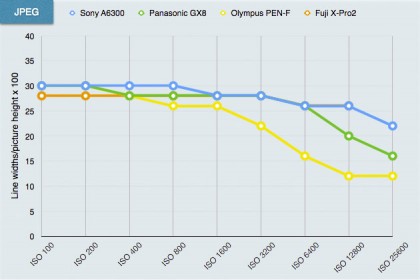
JPEG resolution analysis: The A6300 leads the way for detail resolution amongst its competition here.
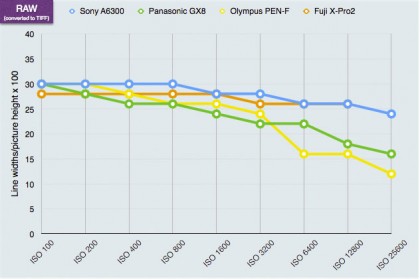
Raw (converted to TIFF) resolution analysis: The A6300 puts in an impressively consistent performance, managing to maintain a high level of detail into the high sensitivity settings.
Dynamic range is a measure of the range of tones the sensor can capture. Cameras with low dynamic range will often show ‘blown’ highlights or blocked-in shadows. This test is carried out in controlled conditions using DxO hardware and analysis tools.
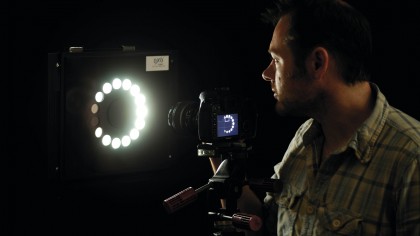
Read: Noise and dynamic range results explained
Dynamic range is measured in exposure values (EV). The higher the number the wider the range of brightness levels the camera can capture. This falls off with increasing ISO settings because the camera is having to amplify a weaker signal. Raw files capture a higher dynamic range because the image data is unprocessed.
Sony A6300 dynamic range charts
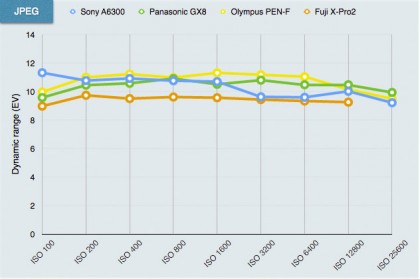
JPEG dynamic range analysis: Lab testing shows a great performance with regards to dynamic range at lower and higher sensitivities next to its immediate rivals, with just a slight dip in the ISO3200-6400 region. Nevertheless the X-Pro2 does a little better for much of the sensitivity range.
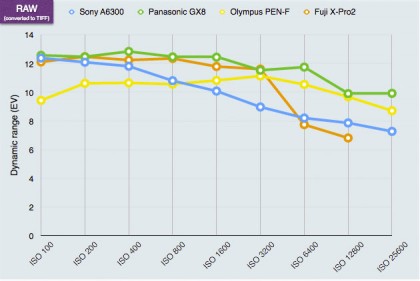
Raw (converted to TIFF) dynamic range analysis: Dynamic range in raw files starts at a reasonable level, although by ISO400 this starts to slip, and at the highest settings performance from the Panasonic GX8 and Olympus Pen-F is considerably stronger.
This is a test of the camera’s noise levels. The higher the signal to noise ratio, the greater the difference in strength between the real image data and random background noise, so the ‘cleaner’ the image will look. The higher the signal to noise ratio, the better.
Sony A6300 signal to noise ratio charts
JPEG signal to noise ratio analysis: The A6300 does an excellent job to match the signal to noise performance of its rivals at its base ISO, and remains strong as sensitivity is raised. Even at the highest settings tested, the readings show it to be very capable.
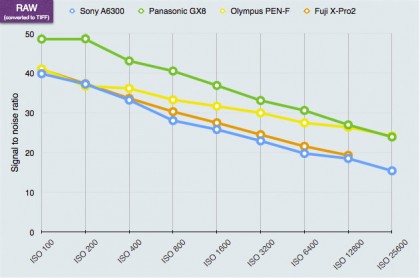
Raw (converted to TIFF) signal to noise ratio analysis: Despite strong JPEG results, the camera fails to keep up with the competition when raw images are analysed here. Performance is consistent across the sensitivity range, but sadly lower throughout.
While there’s room for improvement in terms of design and operation, the A6300 is nevertheless a competent and reliable camera that does what it sets out to do very well. Crucially, it captures pleasing images on standard settings and records video to a high standard.
The previous A6000 can currently be had for less than half the price of the A6300, and this could make the newer model appear overpriced – although those using the viewfinder or focus tracking with some frequency, or needing 4K video recording to hand, may find this premium more reasonable.
Still, the model isn’t short of strong competitors. Videographers may well be drawn to the cheaper 4K-shooting Panasonic Lumix GX8; that camera’s form, and the additions of an electronic viewfinder and flexible LCD, make it seem like the A6300’s closest rival, while the company’s bulkier GH4 or the GH4R update are also viable alternatives if video recording is key.
Those not fussed about 4K video resolution can also turn to the excellent Olympus OM-D E-M5 II or newer Pen-F, both of which offer the advantage of built-in image stabilization over the A6300, and many prospective purchasers may also add the Fujifim X-T1, and even one of Sony’s similarly priced A7-series models, to their shortlist.
We liked
There’s plenty to like about the A6300. Its focusing system is sound, replete with options for capturing a range of different subjects and performs strongly when tracking moving subjects, while the viewfinder is a pleasure to use. The tiltable screen makes composing images at ground level or high up easy. Video quality is excellent, and images are pleasing straight out of the camera.
We disliked
In the absence of any significant failings, it’s only really a handful of smaller shortcomings that let the A6300 down. The screen feels somewhat underpowered; some of the controls aren’t quite as accessible as they could be; and the lack of in-camera raw processing is a shame. Furthermore, while the tiltable LCD is great, it’s shame it’s not a touchscreen.
These are all minor issues though, and none of them should realistically discourage anyone interested in what the A6300 offers.
Final verdict
The A6300 is a well-rounded model that should have wide appeal, both on account of what it offers on paper and its performance in a range of situations.
Those intending on using the A6300 for more considered video recording, or for tracking moving subjects (or both) are likely to be very pleased with what the camera offers, while the excellent electronic viewfinder also makes it a good choice for traditionalists who may have reservations about moving away from optical types. It’s only really a handful of design and handling issues that let it down, making it slightly less convenient to operate than needs be.
Those who are tempted by what the camera offers but are on a budget should consider the previous A6000, which is still available at a temptingly low price.